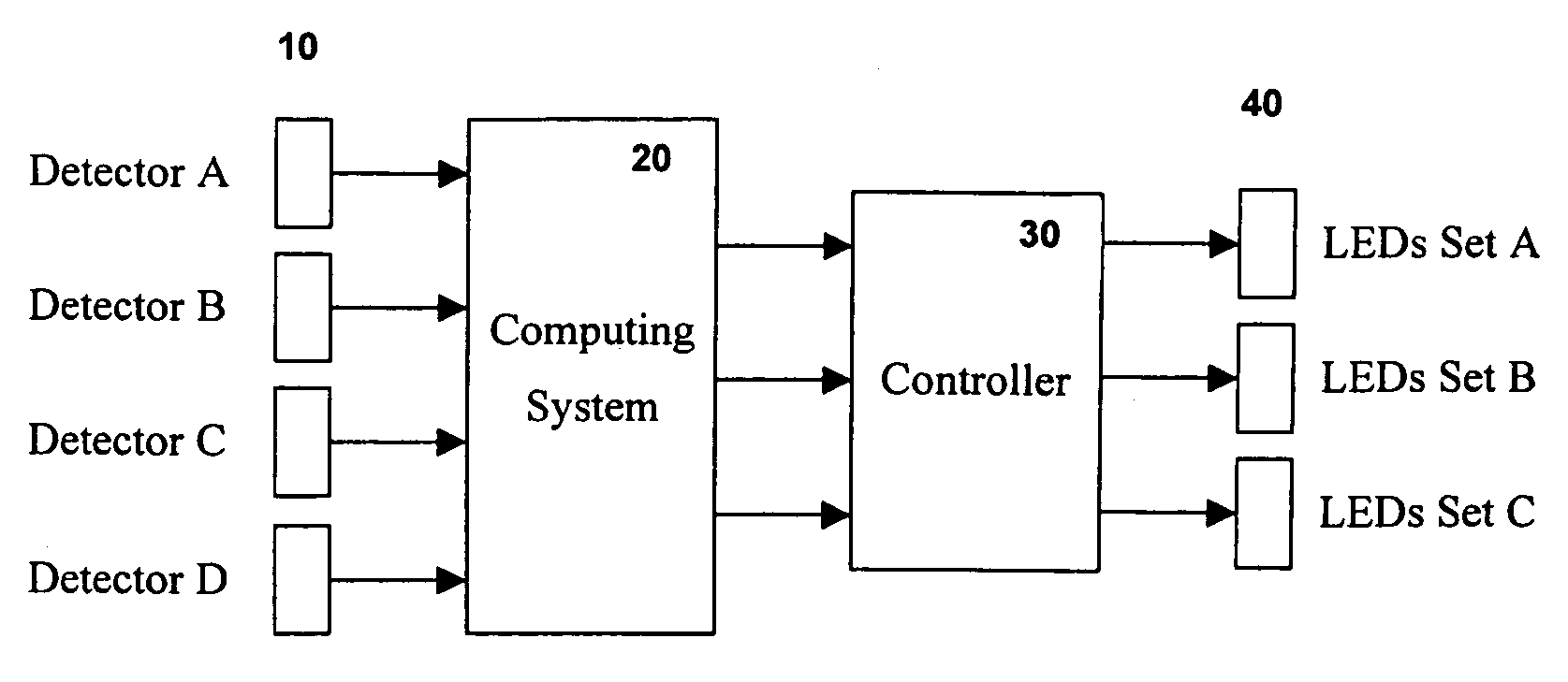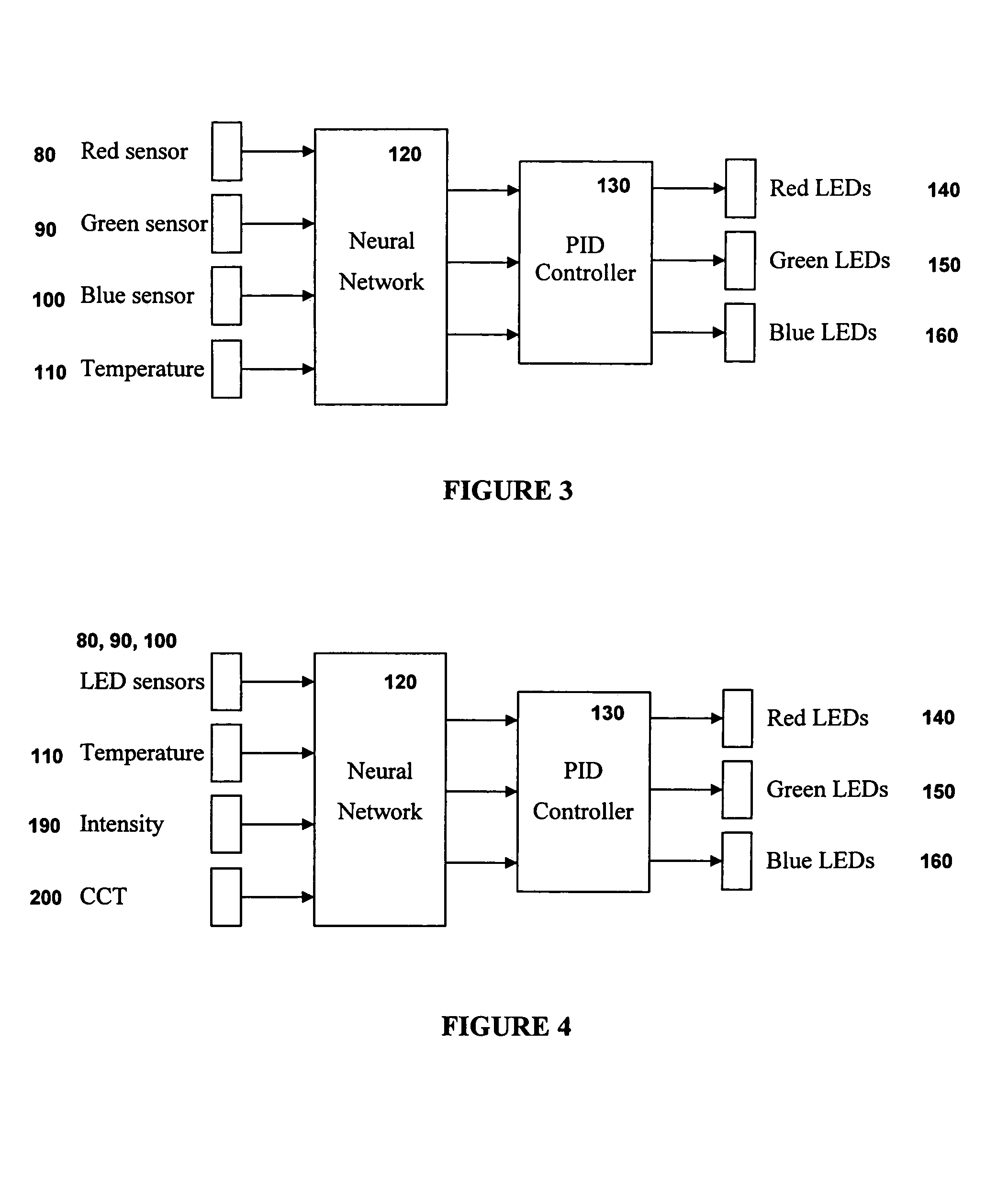Control system for an illumination device incorporating discrete light sources
a control system and light source technology, applied in the field of illumination control, can solve problems such as preventing the effective use of linear pid controllers
- Summary
- Abstract
- Description
- Claims
- Application Information
AI Technical Summary
Benefits of technology
Problems solved by technology
Method used
Image
Examples
example 1
[0038]In one embodiment and with reference to FIG. 3, the illumination system comprises light-emitting elements producing illumination having colours of red 140, green 150 and blue 160, detecting devices enabling the evaluation of the illumination intensities of the colours red 80, green 90 and blue 100 together with information relating to the junction temperatures 110 of the light-emitting elements. The computing system is a neural network 120 which is trained with known input data and desired responses using supervised learning techniques such that it can automatically determine the non-linear multivariate function representing the desired hyperplane. In operation, the neural network essentially linearises the sensor signals as input to a conventional proportional integral-derivative (PID) controller 130 which provides the control signals, in the form of current variations to the light-emitting elements in order to maintain constant luminous intensity and chroma.
example 2
[0039]In another embodiment and with reference to FIG. 4, the illumination system comprises the elements outlined in Example 1, and further comprises detecting devices which enable the input of user requests regarding desired luminous intensity 190 and correlated colour temperature (CCT) 200. Optionally, an additional user-controlled input or detecting device can provide an indication of the desired chromaticity in a direction orthogonal to the blackbody locus to effect a desired change in tint of nominal “white” light without changing its correlated colour temperature, for example. In this embodiment, the neural network that is trained with appropriate known input data and desired responses such that the chroma is constrained to follow that of the blackbody locus in CIE 1976 u-v uniform chromaticity space to generate nominal “white” light at different correlated colour temperatures, or CCT.
example 3
[0040]In another embodiment and with reference to FIG. 5, the illumination system comprises the elements outlined in Example 1, and further comprises a further detection device in the form of a second colourimeter in order to monitor the intensity and approximate spectral distribution of ambient illumination due to the combination of the luminous flux emitted by the luminaire and daylight 220 and / or other light sources. In this embodiment, the neural network is trained such that the intensity and correlated colour temperature of the ambient illumination, or perceived lighting conditions which are a combination of the illumination from the illumination system and other sources, is held approximately constant or follows a user-defined correlation with the intensity and correlated colour temperature of daylight illumination. For example, if there was an increase in the ambient lighting conditions, due to an increase in the propagation of sunlight into an area, and based on the desired ...
PUM
 Login to View More
Login to View More Abstract
Description
Claims
Application Information
 Login to View More
Login to View More - R&D
- Intellectual Property
- Life Sciences
- Materials
- Tech Scout
- Unparalleled Data Quality
- Higher Quality Content
- 60% Fewer Hallucinations
Browse by: Latest US Patents, China's latest patents, Technical Efficacy Thesaurus, Application Domain, Technology Topic, Popular Technical Reports.
© 2025 PatSnap. All rights reserved.Legal|Privacy policy|Modern Slavery Act Transparency Statement|Sitemap|About US| Contact US: help@patsnap.com



